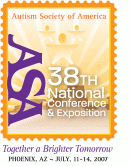 |
The ASA's 38th National Conference on Autism Spectrum Disorders (July 11-14, 2007) of ASAThe Westin Kierland Resort & Spa, Scottsdale, AZ |
| For a complete author index with session numbers, please click here | |
| Thursday, July 12, 2007: 3:00 PM-4:15 PM | |||
| Rainmakers Ballroom C | |||
| #2620- Evidence-based Literacy Interventions: Strategies for Students with Autism Spectrum Disorders- ASHA CEU Session* | |||
| This presentation offers an overview of research-based literacy programs and strategies for students with significant learning needs and autism. These strategies will be presented within the positive behavioral interventions and supports (PBIS) three-tier framework of academic and behavioral instruction. Specifically, we will describe school-wide interventions, targeted interventions, and intensive individualized interventions for reading instruction. | |||
| Presenters: | - Christi Carnahan is a doctoral student at the University of Cincinnati. She serves as a consultant for school districts seeking to improve services for children with autism spectrum disorders (ASD). Christi works collaboratively with the Ohio Center for Autism and Low Incidence. Her research interests include improving learning outcomes for students with ASD by increasing teacher efficiency. She has presented her work at local, state and national levels including local professional organizations (ASGC), school districts, the Kelly O’Leary Center and Cincinnati Children’s annual conference, regional trainings, the Ohio Middle Level Conference and the American Education Research Association Conference (AERA).
- Sheila Smith is a doctoral student at the University of Kansas. Her research interests include utilizing technology to improve learning outcomes for students with autism spectrum disorders (ASD) and increasing teacher efficacy. Her focus is students with asperger syndrome and high-functioning autism. She has presented her work at local, state, national, and international levels. She has also published journal articles and book chapters related to ASD. She is currently the autism internet module (AIM) development specialist at the Ohio Center for Autism and Low Incidence (OCALI), creating open access modules for use in K-12, higher education, and the community. | ||
|
| |||
|
Abstract and Relevance Relevance: There are many factors to consider when determining the best reading resources and strategies. When working with children with autism, who are unique individuals having different strengths, challenges, learning styles, linguistic and cultural backgrounds, as well as a spectrum of disabilities, determining the best resources and strategies that will meet all of their varied and unique characteristics is even more difficult. Learning to read requires programs, resources, and strategies that address the academic content standards. However, designing literacy instruction for students with autism requires attention to several other factors. Professionals must address biological and sensory factors across learning environments, and issues of motivation and reinforcement. Other important considerations include visual and structural accommodations and supports, and ensuring that the level of task demand meets each child's instructional level. Prerequisite and missing skills must also be identified and taught. Finally, and perhaps most important, professionals must ensure that that the language used during reading instruction is comprehensible to students with autism and significant learning needs. Teaching reading is a complex process that often leaves professionals feeling overwhelmed or inadequate. This presentation offers an overview of research-based literacy programs and strategies identified in the literature for students with significant learning needs and autism. These strategies are then discussed in terms of the positive behavioral intervention and supports (PBIS) three-tier framework of academic and behavioral instruction. Specifically, we will describe practical school-wide interventions, targeted interventions, and intensive individualized interventions. Though no single program or strategy was identified as adequate to address all aspects of literacy instruction; each is designed to target a specific instructional area. As children are varied, the make-up of schools and classrooms is also varied. Throughout the presentation, we recommend that these programs and strategies be thought of as fluid interventions that can move among the tiers on a continuum. Some programs and strategies that are targeted interventions in one school may be school wide interventions, or intensive individualized interventions at another based on the unique make-up of each individual school community. This presentation will: - Provide an overview of specific considerations for designing literacy instruction for students with autism and significant learning needs. These considerations are based in the literature on the learning characteristics of students with autism. - Offer practical, evidence-based strategies for designing literacy instruction for students with autism and significant learning needs. These strategies align with the guidelines provided by the National Reading Panel. - Link specific strategies to a three-tier model for academic and behavioral intervention. - Briefly describe the areas of needed research in the field of autism and literacy instruction. |
|||
See more of General Submissions
See more of The ASA's 38th National Conference on Autism Spectrum Disorders (July 11-14, 2007)